As their name suggests, jewel cichlids are both strikingly beautiful and, well, cichlids. This means that a sparkling flash of color in your tank comes with a fiery personality to match.
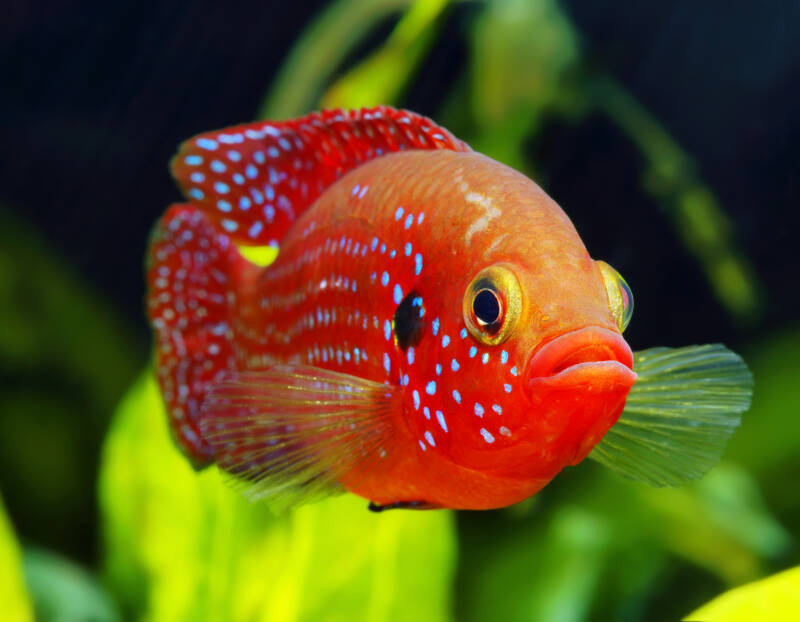
The jewel cichlid (Hemichromis bimaculatus) goes by several names, including blue or green or popular red jewel cichlid and African jewelfish.
It is occasionally mistaken for another African cichlid with the scientific name Hemichromis letourneuxi, which has a similar appearance and is an invasive species in parts of Florida.
Jewels are considered an aggressive cichlid species and are best for experienced aquarists who can manage that aggression.
In the right environment, these fish are active, responsive to their owners, and excellent parents.
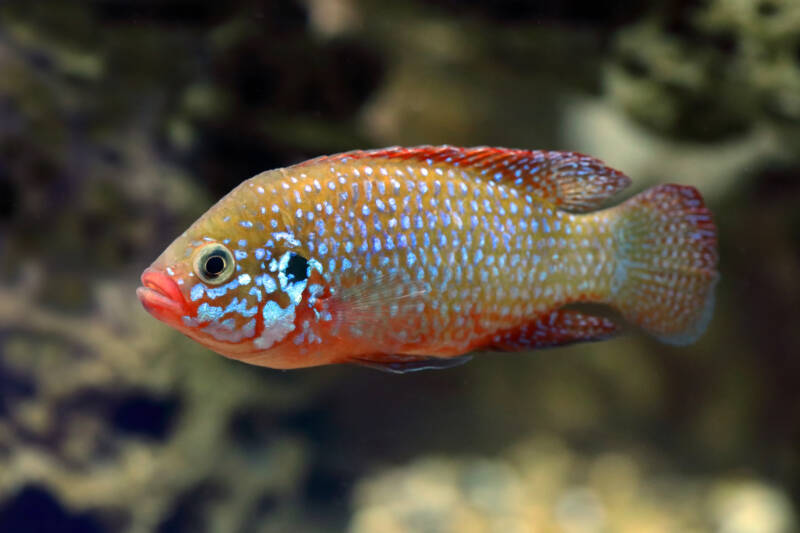
Read on for more on the care and breeding of the jewel cichlid.
At a Glance
| Minimum Tank Size: | 40 gallons |
| Group Size: | Singly or in pairs |
| Water Temperature: | 75 to 80°F (24 to 27°C) |
| pH: | 6.5 to 7.5 |
| Hardness: | 4 to 16 dGH |
| Lifespan: | 5 years |
| Breeding: | Substrate spawner |
| Adult Size: | 6 inches (15 cm) |
| Usual Place in the Tank: | All levels, mostly bottom |
[toc]
Natural Habitat
This fish is a river and lake-dwelling species from West Africa. It is widely distributed in Guinea, Sierra Leone, and Liberia.
The waters they inhabit have muddy bottoms and are rich with overhanging and floating vegetation.
Appearance and Biology
The body shape of the jewel is long, pointed, and compressed laterally. It has large eyes and a strong, upward-turned mouth.
Just past the head, a hump rises then blends into the rest of the body.
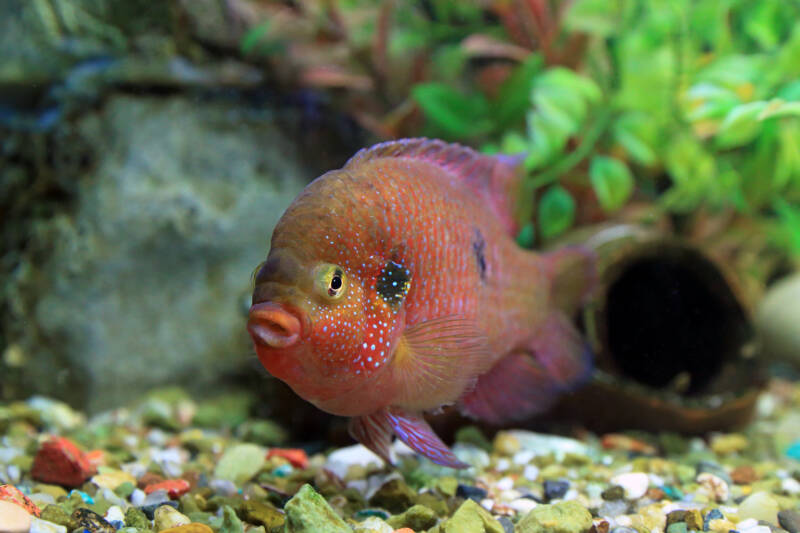
The dorsal fin covers the rear two-thirds of the body, sweeping backward and ending just past the base of the tail fin.
The anal fin sweeps backward in a similar manner, ending at the same place.
A row of up to three black dots appears just above the lateral line.
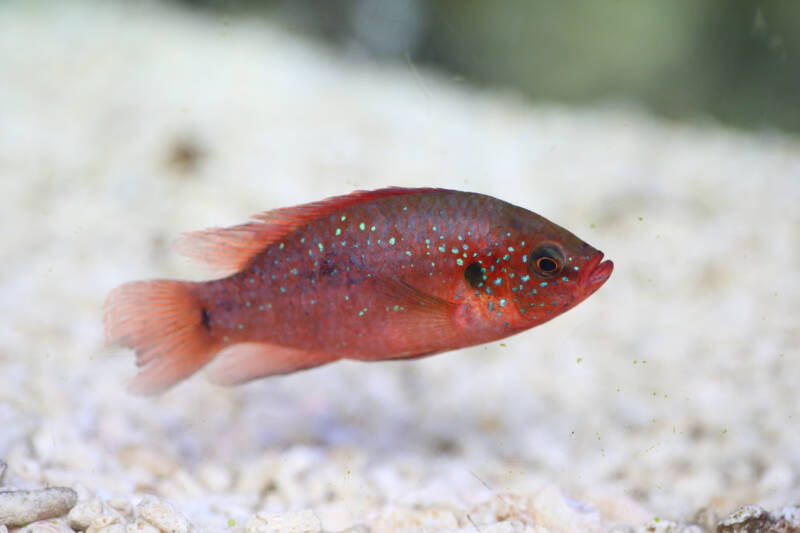
The first dot appears behind the eye on the gill cover, the second just past the mid-point of the body, and the last near the base of the tail.
Coloration
The jewel cichlid is a colorful fish that comes in two variations, one with a red/orange base color and another in gray/blue. Both variations have brilliant turquoise dots over the body and fins.
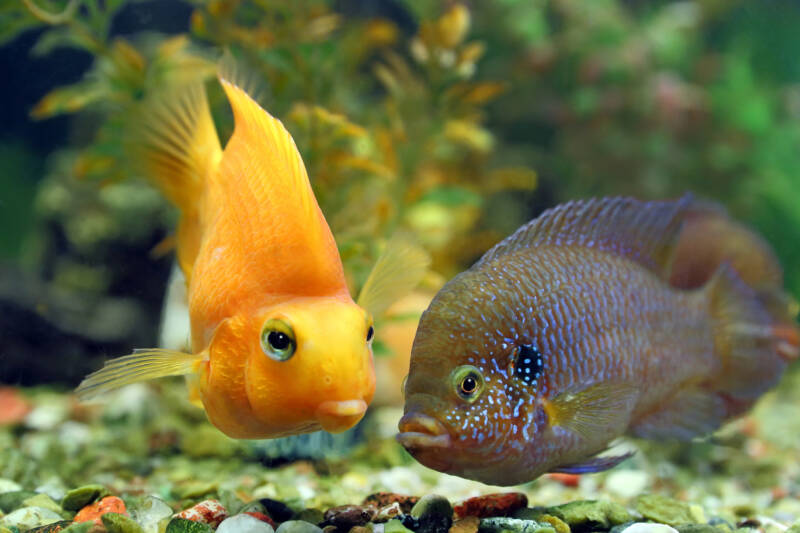
When the fish are happy and healthy, their colors appear brighter. If they are unwell or stressed, their colors will be dull.
A juvenile cichlid’s colors may be dull when you first purchase them, but with good care, you should see them brighten.
Gender Differences
How can you tell if a jewel cichlid is male or female? There is very little differentiation to determine which fish are male or female.
Look for a slight point to the male’s dorsal fin and a net-like pattern on the tail.
Size
In captivity, the jewel cichlid will grow to a length of about six inches (15 cm). Interestingly, wild cichlids can grow significantly larger, up to a foot (30.5 cm) in length!
How fast do jewel cichlids grow?
Newborn fry will reach a length of about 0.4 inches (1 cm) in about a month. Adults reach their maximum size in about two years.
Lifespan
With proper care, expect your jewel cichlid to have a lifespan of about five years.
The most important factors influencing your fish’s lifespan will be water quality, diet, and overall tank environment.
This is one species that benefits greatly from the most peaceful environment you can establish. Their tendency toward aggression means a higher potential for stress and injury.
Behavior
These fish are playful and active. They often bond with their owners and visibly react when they are fed.
They explore all tank areas but favor a chosen territory, especially if they have formed a bonded pair. When they reach adulthood, they tend to stay near their chosen shelter.
Are jewel cichlids aggressive?
There are certain situations where a jewel cichlid will become aggressive. These fish are highly territorial and will actively defend an area they have selected as their own.
Aggression can be managed by ensuring the tank size is large enough to accommodate the number of fish and providing numerous hiding spaces so that each fish can establish a territory.
Jewels are fin nippers and will take a swipe at any slow-moving or long-finned fish.
Higher levels of stress or inadequate feeding can increase their tendency to nip at others. During mating times, their level of aggression can increase significantly.
How many per gallon?
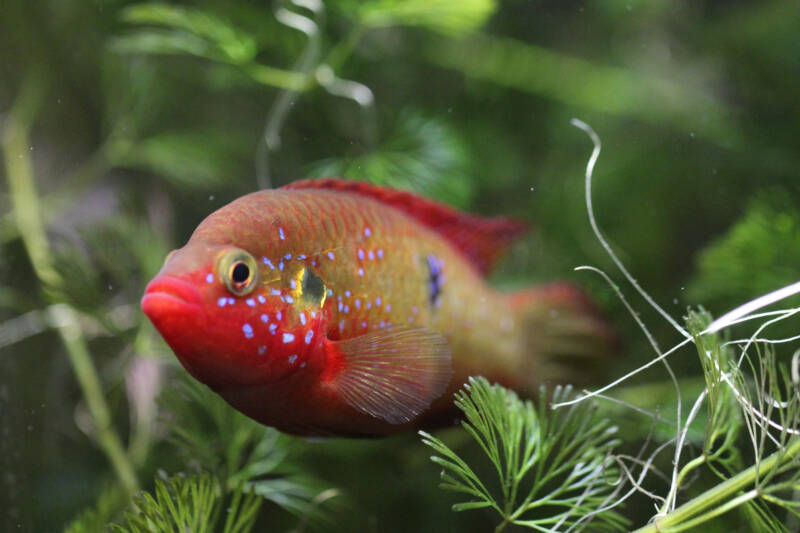
How many jewel cichlids can be kept together? Start with a 40-gallon tank for a single jewel cichlid.
If you plan on keeping more than one, increase your tank size by 10 gallons for each additional fish. Keep these fish singly or in pairs.
These are minimum tank size recommendations. Naturally, with a fish that needs swimming space and has a tendency toward aggression, the larger a tank size you can provide, the happier your fish will be.
Tank Setup
The goal for setting up a jewel cichlid tank is to recreate their natural habitat as closely as possible.
Decorations
The jewel is a digger, so line the bottom of the tank with a soft, sandy substrate. You do not want them rooting around in anything with rough edges.
Add large rocks, clay pots, or driftwood to create hiding spaces and territories that your cichlids can claim.
Take care when adding live plants, as your cichlids may uproot them.
Consider floating plants, such as java moss and hornwort. These will oxygenate the water, control contaminants, and provide shaded areas, which your cichlids will appreciate.
Conversely, you can secure your rooted plants by placing larger stones around their base.
Water Conditions
The jewel cichlid is a warm water fish, so plan on water parameters that match its native habitat.
Keep the temperature in the range of 75 to 80 degrees Fahrenheit (24 to 27 degrees C).
The pH should stay between 6.5 and 7.5 and the hardness between 4 and 16 dGH.
Equipment
Install a heater and thermometer to monitor the water temperature and keep it consistent.
Cichlids are notoriously messy, so select a sturdy, external filter to keep your water quality high.
Finally, this species prefers moderate to soft lighting, which you can provide through the lighting system or the addition of plants.
Tank Mates
There are two camps of differing opinions on placing the jewel cichlid in a community tank or a single species tank.
Because of their aggression and territorial behavior, the simplest solution is a bonded pair. When you place other fish in the tank, take care and consider some of the following.
Avoid placing the following with your jewel cichlid:
- Larger, more aggressive fish
- Smaller, more peaceful fish
- Slow-moving fish with long fins.
What fish can go with jewel cichlids?
Some Central and South American cichlids make decent tank mates for the jewel. These fish are not overly aggressive, provided you have an appropriate tank setup.
Consider the Jack Dempsey, firemouth cichlid, green terror, or some parrots.
Fast swimming, schooling fish can also pair well. These “dither fish” help keep the peace by providing a distraction and thereby reducing aggression.
Barbs make a great choice, especially tiger barbs in a group of 5 to 10.
Bottom feeders can also work well. When adding plecos or catfish, ensure you have an adequate tank size to accommodate them with your cichlid.
Can you put a jewel cichlid with Oscars?
We would not recommend keeping your jewel cichlid with an Oscar. Oscars get quite large and are also aggressive – two parameters to avoid when pairing your jewel cichlid.
Food and Diet
Jewel cichlids are omnivores and not especially picky ones at that.
They are benthopelagic predators of convenience in the wild, taking advantage of available food sources along the stream bottom.
Feed your fish a high-quality flake food or cichlid pellet six days a week and allow one day without food for digestion.
A couple of times a week, switch to live or frozen foods, such as bloodworms or brine shrimp, to round out their diet. An occasional meal of algae wafers, spirulina flakes, or blanched spinach will satisfy their vegetable needs.
Will jewel cichlids eat guppies?
Yes, however, we do not recommend guppies as live food for your cichlid. These are not a natural part of the jewel’s diet, and the practice of using feeder guppies can increase the risk of introducing pathogens into your aquarium.
Breeding

Jewel cichlid breeding involves bonding, establishing a territory, cleaning a spawning site, courtship, and parenting the young.
These monogamous fish maintain lifetime breeding bonds. Try starting with a group of fish and allowing them to pair naturally. Separate the pairs after they have formed to reduce aggression.
Tank Setup
The jewel is a substrate spawning cichlid species. Place a flat rock at a slight angle on the bottom of the tank on which the female can deposit her eggs.

If you keep your cichlids in a community tank or with other jewels, consider a tank divider to minimize aggression.
Keep the water soft and slightly acidic, in the range of pH 6.5 to 7.0.
Spawning
Raise the water temperature a couple of degrees to encourage spawning.
Feed your fish high nutrient, live foods. When ready to spawn, your fish may show bright colors.
The female will deposit a line of eggs before moving on to let the male fertilize them. When they are finished, there could be as many as 600 eggs in your tank!
Caring for the Fry
The eggs hatch in about 48 hours and both parents care for the eggs and guard the territory.
Over the next few days, the parents may dig holes in the substrate and move their fry. This can happen several times until the fry become free-swimming.
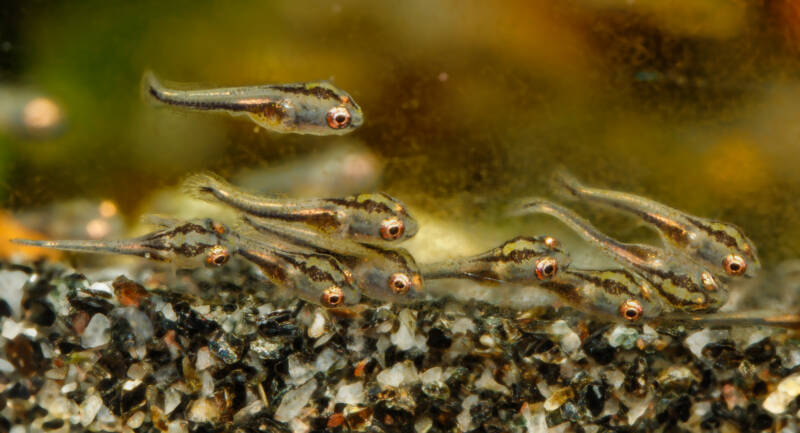
Once they are free swimming, feed your fry infusoria, liquid fry food, nauplii, or micro worms. As they grow, transition to crushed flakes and baby brine shrimp.
The parents will continue to care for the fry for about a month. At that time, the fry should have reached a length of about 0.4 inches (1 cm), and it is best to separate them from the parents.
The parents may be ready to breed again, which could result in aggression toward their young.
Hardiness
Overall, the jewel cichlid is a hardy fish. Read up on the symptoms and treatment of common freshwater tank ailments.
Most can be treated by isolating the infected fish, correcting water conditions, and treating your fish with medication.
Closing Thoughts
The jewel cichlid is an excellent choice for an experienced aquarist. This fish is an active, interesting, and beautiful addition to a home aquarium.
Breeding them is simple, and they have strong parental instincts.
Knowing the jewel’s behavior tendencies, setting up an appropriate tank, and monitoring tank mate interactions are vital to raising happy, healthy fish.
Comment below and let us know your experiences with keeping jewel cichlids.
What species have you successfully paired with your jewel in a community tank?
